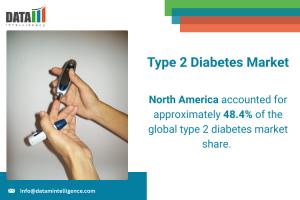Type 2 Diabetes Market Projected to Reach US$ 124.26 Bn by 2033 Amidst Technological Advancements | DataM Intelligence
Type 2 Diabetes market is projected to grow at a CAGR of 8.2% through 2033. Key drivers include advancements in pharmacotherapy and digital health platforms.
Artificial intelligence (AI) and machine learning (ML) are playing a pivotal role in reshaping the Type 2 Diabetes landscape in 2025. These technologies are enabling earlier detection, risk prediction, and tailored treatment regimens through real-time data analysis. Healthcare providers are increasingly using AI tools to streamline workflows and proactively monitor patients, while consumers are adopting smart apps that track glucose levels, diet, and physical activity. This trend is reflected in rising investments from both pharmaceutical and digital health companies aiming to integrate data-driven tools into the care continuum.
The market is also witnessing major strategic developments. In April 2025, Eli Lilly’s oral GLP-1 drug, Orforglipron, reported positive results in Phase 3 trials, offering a once-daily, non-injectable option for Type 2 Diabetes management. Meanwhile, Novo Nordisk entered a $2.2 billion collaboration with Septerna to develop novel oral therapies, and the U.S. FDA approved a generic version of Victoza (liraglutide) to improve drug accessibility. In Europe, Dexcom secured CGM reimbursement in France for T2D patients on basal insulin, expanding digital care to over 100,000 patients. With such developments, 2025 is emerging as a milestone year for innovation and market expansion in the global Type 2 Diabetes sector.
Get The Premium Sample PDF: https://www.datamintelligence.com/download-sample/type-2-diabetes-market
North America Dominates the Type 2 Diabetes Market
The Type 2 Diabetes market is experiencing significant growth, propelled by rising prevalence rates and advancements in treatment options. North America holds a dominant position, accounting for approximately 48.4% of the global market share, driven by a robust healthcare infrastructure and high incidence rates.
The Asia-Pacific region, particularly in Japan, the market is witnessing rapidly growing at a CAGR of 9.7%. This growth is attributed to an aging population, increased healthcare spending, and supportive government initiatives.
Leading Market Players in Type 2 Diabetes Market:
The major players in the type 2 diabetes market are Novo Nordisk A/S, Eli Lilly and Company., Sanofi, Pfizer Inc., Johnson & Johnson Services, Inc., AstraZeneca, Boehringer Ingelheim Pharmaceuticals, Inc., Merck & Co., Inc., Viatris Inc., and Teva Pharmaceutical Industries Ltd., among others.
Key Industry Developments on Type 2 Diabetes Market:
• Eli Lilly and Company (April 2025): Eli Lilly announced positive Phase 3 trial results for its investigational oral GLP-1 receptor agonist, Orforglipron. The once-daily pill, taken without food or water restrictions, demonstrated a 1.6% reduction in A1C from a baseline of 8.0% at the 12 mg dose level. This positions Orforglipron as a promising non-injectable option for Type 2 diabetes management.
• FDA Approval of Generic Liraglutide (April 2025): The U.S. FDA approved a generic version of Victoza (liraglutide) for the treatment of Type 2 diabetes, marking a milestone in improving treatment affordability and access to GLP-1 therapies.
• In May, 2025, Novo Nordisk announced a collaboration and licensing agreement with U.S.-based biotech company Septerna, potentially worth up to $2.2 billion, to develop oral small molecule treatments for obesity, Type 2 Diabetes, and other cardiometabolic diseases.
• In July 2024, Novo Nordisk announced that the U.S. Food and Drug Administration (FDA) has issued a Complete Response Letter (CRL) regarding the Biologics License Application for once-weekly basal insulin icodec, intended for the treatment of diabetes mellitus. Insulin icodec, marketed as Awiqli is already approved in the EU, Canada, Australia, Japan, and Switzerland for both type 1 and type 2 diabetes, and in China specifically for type 2 diabetes.
• In June 2024, Dexcom, Inc. announced a significant expansion in product accessibility for individuals with Type 2 diabetes (T2D) using basal insulin, as the company secured reimbursement in France for its Dexcom ONE sensor—benefiting around 100,000 patients with suboptimal glycemic control (HbA1c ≥ 8%) receiving fewer than three daily insulin injections.
Trending Titles:
Glucagon-like Peptide 1 (GLP-1) Analogues Market Growth By 2031
Digital Health Market Growth By 2031
Sai Kiran
DataM Intelligence 4market Research LLP
+1 877-441-4866
sai.k@datamintelligence.com
Legal Disclaimer:
EIN Presswire provides this news content "as is" without warranty of any kind. We do not accept any responsibility or liability for the accuracy, content, images, videos, licenses, completeness, legality, or reliability of the information contained in this article. If you have any complaints or copyright issues related to this article, kindly contact the author above.
NEW BOOK PUTS SPOTLIGHT ON CARING FOR DEMENTIA CAREGIVERS
Pure Visibility, Inc. Launches Marketing Recharge to Spark Connection in Ann Arbor’s Marketing Scene
From Dutch Costumes to Cacti: Award-Winning Picture Book Explores Mexican-American Roots in 'Where Nopalitos Grow'
Kalendarium
Więcej ważnych informacji
 Jedynka Newserii
Jedynka Newserii

 Jedynka Newserii
Jedynka Newserii

Handel

Ważą się losy nowej umowy między Unią Europejską a Ukrainą na temat zasad handlu. Obecne przepisy wygasają 5 czerwca
5 czerwca wygasa ATM, czyli wprowadzona przed trzema laty i potem z modyfikacjami przedłużana umowa między UE a Ukrainą, liberalizująca zasady wwozu ukraińskich towarów na teren Wspólnoty. Strona ukraińska chciałaby jej przedłużenia, na razie jednak Unia zgodziła się jedynie na przedłużenie bezcłowego przywozu żelaza i stali. Największe obawy, zwłaszcza w Polsce, budzi kwestia produktów rolnych. Zdaniem europosłanki Konfederacji Anny Bryłki należałoby wrócić do obowiązującej przed 2022 rokiem umowy stowarzyszeniowej DCFTA, ponieważ Ukraina może dziś eksportować swoje towary drogą morską poprzez porty na Morzu Czarnym, a dzięki darmowemu dostępowi do unijnego rynku bogacą się jedynie potentaci rolni.
Ochrona środowiska
Nowe technologie pomagają szybciej i dokładniej sortować odpady. Wciąż nie wszystkie da się jednak przetworzyć

Do 2030 roku 55 proc. odpadów opakowaniowych z tworzyw sztucznych powinno trafiać do przetworzenia. W ubiegłym roku było to ok. 27 proc. Nowe technologie w coraz większym stopniu ułatwiają sortowanie odpadów, ale nie pozwalają jeszcze na przetworzenie wszystkich ich rodzajów. To pierwsze wyzwanie związane z zamykaniem obiegu. Kolejnym jest zwiększanie zawartości materiałów pochodzących z recyklingu w produkowanych opakowaniach, czego wymagają unijne przepisy. Choć w tym obszarze widać w ostatnich latach znaczące postępy, nie brakuje wyzwań.
Handel
Rosyjskie surowce przestaną płynąć do UE. Spóźniony, ale ambitny i istotny plan ma być wdrożony do 2027 roku

– Kupowanie surowców energetycznych z Rosji jest jak kupowanie broni przeciwko Ukrainie – uważa europosłanka PO Mirosława Nykiel. Dlatego KE planuje do 2027 roku ograniczyć do zera import rosyjskich paliw. Joanna Scheuring-Wielgus ocenia, że taka decyzja powinna zapaść już dawno, ale lepiej późno niż wcale. Co więcej, państwa członkowskie powinny być w tych deklaracjach zjednoczone najbardziej, jak się da.
Partner serwisu
Szkolenia

Akademia Newserii
Akademia Newserii to projekt, w ramach którego najlepsi polscy dziennikarze biznesowi, giełdowi oraz lifestylowi, a także szkoleniowcy z wieloletnim doświadczeniem dzielą się swoją wiedzą nt. pracy z mediami.










.gif)

 |
| |
| |
|